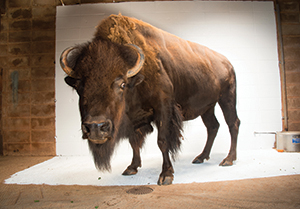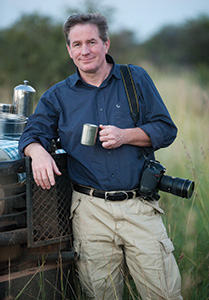Joel’s Photo Ark
He’s been chased by wolves, polar bears and elephants—and it’s part of his job. Joel Sartore has spent more than 20 years contributing wildlife photographs to popular journals including National Geographic and Newsweek and traveled on assignment to every continent. However, his true life’s calling began ten years ago—to photograph every captive species of animal, before it is lost.
The Photo Ark
 Of the 5,800 species he has currently documented, some have already become extinct. The Costa Rican golden toad and the Columbian Basin pygmy rabbit are now gone forever. In some cases, his photographs are the only proof that these animals even existed on earth.
Of the 5,800 species he has currently documented, some have already become extinct. The Costa Rican golden toad and the Columbian Basin pygmy rabbit are now gone forever. In some cases, his photographs are the only proof that these animals even existed on earth.
This knowledge has fueled his desire to keep going and to work faster. In the past year alone, he has photographed 1,500 different species. It’s a personal mission, so he does it on his own time and raises his own funds through grants, writing books and speaking fees. He calls his work the Photo Ark.
“It’s important to keep building the ark and bringing species on board,” Sartore said. “Hopefully some of them can be saved from the extinction crisis.”
His style has become iconic. Highly-detailed, look em’ in the eye photographs of animals against black or white backdrops. It’s not the work of computer graphics, either. With the help of animal caretakers, the animals are posed against backdrops of paint, paper or cloth.
“Hopefully by meeting the animals in an intimate eye-to-eye way, people will care enough to wonder what they can do to save the species,” Sartore said. “You don’t have to save the whole world, but you can do something in your own backyard like planting milkweed for the monarch butterflies.”
Being a world-renowned animal photographer isn’t nearly as exciting as it sounds. It sometimes involves hours of prep work and then more waiting for the animal to move into the right position. He’s endured frigid cold and blazing heat. During his last visit to photograph animals at the Oklahoma City Zoo, which included bison, lungfish and the oriole warbler, the heat index was over 100 degrees. Temperature, however, is not enough to diminish Sartore’s joy while at the camera or his overriding goal to expose people to nature.
A Born Naturalist
Sartore’s parents raised him to care about the natural world. He grew up hunting, fishing, attending zoo classes and carting home wild animals to become family pets. “I would have gone into biology, but I couldn’t handle the math and chemistry, so I became a journalist instead—and that’s what enabled me to see the world,” Sartore said.
Sartore was born in Ponca City, but he moved to Nebraska during his childhood years. As a result, Oklahoma seemed like, “a distant, exotic place of red earth and southern accents.” He now strives to teach people that all states, including Oklahoma, have rich biological treasures in terms of species diversity, and that, “there’s more to the Great Plains than deer, turkey and bass.”
Animal and Artistic Influences
He’s been touted as the modern-day John James Audubon, the influential 1700s American naturalist known for his bird paintings, but Sartore denies the comparison. “Audubon observed birds and drew them in incredible detail, from memory! He’s my hero,” Sartore said. “Audubon’s paintings and testimonials—like descriptions about the behavior of the passenger pigeon. He could see even then that some of these vibrant animals were in trouble.”
 Sartore also admires the efforts of portrait artist, George Catlin, who saw the looming demise of Native American cultures in the 1800s. Catlin’s paintings document the clothing and customs of tribes that no longer exist. “The work of Audubon and Catlin is amazing, and it’s all that we have.”
Sartore also admires the efforts of portrait artist, George Catlin, who saw the looming demise of Native American cultures in the 1800s. Catlin’s paintings document the clothing and customs of tribes that no longer exist. “The work of Audubon and Catlin is amazing, and it’s all that we have.”
Whether Sartore admits it or not, he’s following in their footsteps. An animal doesn’t need the beauty of a parrot or the appeal of a monkey to capture Sartore’s attention. He’s photographed invertebrates, fish and rodents that elude most people’s interest—at least until they are captured by Sartore.
A few years ago, Sartore visited the Palm Beach Zoo to photograph the rare Pondicherry vulture, a not-so-pretty bird with wrinkled pink skin on its bald head. “The zookeepers said that nobody had ever come to photograph him, even though he was the only one living in North America,” Sartore said. “It’s one more example of a species dangerously close to extinction in which there is scant evidence of its existence. That’s why it’s my job to document these things before they are gone.”
To propel his awareness efforts, Sartore has published several books, including Rare: Portraits of America’s Endangered Species. A changing gallery of the photographs he took while in Oklahoma are on display in the Oklahoma City Zoo’s Patricia and Byron J. Gambulos ZooZeum and Noble Aquaticus Center.
“At best, we’ll save some species,” Sartore said. “Maybe we’ll embarrass the government to protect flora and fauna or get a corporation here and there to do the right thing. At worst, the Photo Ark will be a record of what we squandered.”
Learn more about Joel Sartore’s work at www.joelsartore.com.




